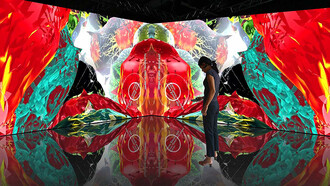Theaster Gates gathers us for his Freedom of Assembly show, at the White Cube Gallery, Bermondsey.
The title of this exhibition refers to the First Amendment in the United States Constitution being freedom of speech, the liberty to peaceably assemble and the free excercise of religion. Diversity being key, whether it be visually or conceptually, Gates’ practice draws us into a pluri-disciplinary world where roots and culture meet politics.
Reading up about Gates, the first aspect that jumped to my attention was the bridge he creates between craft and art. Gates draws upon his father’s profession as a roofer to produce a series of tar paintings for the show. Dispersed throughout the gallery, one is immersed within a set of large semi-monochromatic wood pannel canvases where the texture of this thick, black palbable material creates a bas-relief feel, stemming away from painting without dismissing it.
I am fascinated, and not only by what is in front of my eyes, but also by the idea of using a craft and pushing it through into the realm of fine-art. Where does the artisanal meet the art? Is there even a separation between these two disciplines? An artisan is considered a crafstman, creating works that have a function or purpose, but as we know, that definition equally applies to the art world. Another manifestation of Theaster Gates’ interest in the limits of art and life.
Gates also presents clayworks, small figures of men scattered in corners and a selection of vase-like objects coated with what seems to be strips of tar set on rough wooden pedistils. From tar ‘paintings’ to clayworks, Gates submerges us into the representation of labour and technique incorporated with poetic, delicate movement and the human trace or gesture of making. Along with these works are a set of installations using found materials from derelict buildings in south Chicago. Objects gathered from a disused hardware store, assembled in coarse wooden vitrines or wood battens belonging to a gym floor precisely and tightly lined next to one another forming a canvas-like object-painting transport us into the idea of artefacts or the power of an object.
Again, one can note the influence of ‘purpose’ or craft within Gates’ work. These items have served a precise function and therefore embody a strong representation as well as a substantial past. Gates takes these elements out of context and makes way for them to vehicle a message about the path our society has embarked upon. These ideas on our harsh reality echo into the free and open-ended world of ‘the art gallery’; they therefore take on a whole new sense and become charged with a socio-political message. This transformation occurs from function to vehicle, from characteriszed to ambiguous.
Circling back to the essence of the show, Theaster Gates actively assembles; through meaning and function, technique and vision. Representing the reality of our culture through his art, a reflection of him, you, her or I, and how we live.
All images:
Theaster Gates, Freedom of Assembly 2015, White Cube Bermondsey















